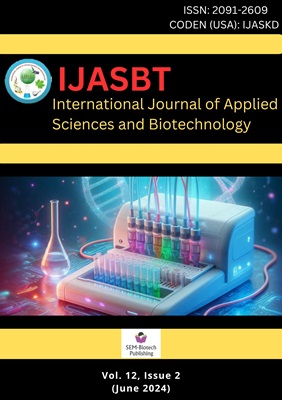Recovery Percentage of Different Coffee Varieties (Coffee arabica) from Fresh Cherry in The Gulmi District of Nepal
DOI:
https://doi.org/10.3126/ijasbt.v12i2.64874Abstract
The recovery percentages and out-turns of diverse coffee cultivars are contingent upon distinct processing methods and fruit characteristics. Despite the availability of numerous coffee varieties, their recovery percentages and out-turns remain untested in the Gulmi District of Nepal. This study aimed to assess the recovery percentage of different coffee varieties in the Gulmi District to provide insights into the most productive varieties for local farmers, investigate the influence of processing techniques on the recovery percentage, and evaluate the potential for improving the recovery percentage through optimized agricultural practices, harvesting methods, and post-harvest processing. A field experiment was conducted in a Randomized Complete Block Design (RCBD) with three replications, encompassing ten coffee varieties (Catisic, Bourbon Amarillo, Mundo Novo, Catimor, Yellow Catura, Catuai Amarillo, Firfire,Sanroman, Gulmi Local, and Tekisic) as treatments. The research findings unveiled that Mundo Novo exhibited the highest recovery percentage at 18.13%, with Catuai Amarillo demonstrating the highest recovery percentage of wet parchment from fresh cherry at 63.13%. Moreover, Mundo Novo showcased the highest recovery percentage of dry parchment from fresh cherry at 24.85%, attributed to the removal of a higher proportion of floated parchment during the washing of fermented wet parchment. Furthermore, Mundo Novo exhibited the highest recovery percentage of green beans (21.13%) and roasted beans (18.13%) from fresh cherries, owing to factors such as a lower incidence of floated parchment, larger fruit size, and uniformly ripened cherries. Consequently, based on their superior recovery percentages and out-turns, Mundo Novo and Catuai Amarillo are recommended for cultivation in Nepal.
Int. J. Appl. Sci. Biotechnol. Vol 12(2): 62-76.
Downloads
Downloads
Published
How to Cite
Issue
Section
License
Copyright (c) 2024 International Journal of Applied Sciences and Biotechnology

This work is licensed under a Creative Commons Attribution-NonCommercial 4.0 International License.




